It was not that long ago that Asian equity desks were one of the hottest places to be, as analysts kept retracing their own predictions amidst a meteoric rise of Chinese stock markets – fast forward a year later and the same desks have become something of an endangered species.
The new world of Online Trading , Fintech and marketing – register now for the Finance Magnates Tel Aviv Conference, June 29th 2016.
To recap, it was almost one year ago that Asian markets were convulsed by an outright collapse in Chinese equity indexes, in which composites such as the Shanghai plunged nearly 30% in the course of a month. Chinese state measures in the immediate sense had done little to allay the nerves of investors, which mostly relied on circuit breakers or suspended trading to help mitigate the panic permeating through the market.
However, the narrative nearly one year later is that of a shrinking business, which could not have seemed more implausible during the run up that led many to call it a stock market bubble. Consequently, Asian equity desks have been in marked decline, while many lenders are pulling out of the business entirely.
Looking at the numbers, there is no single factor that caused such an extant flow of business over the past twelve months, though the aforementioned crash as well as the Fed’s interest rate policy did not help matters. According to a recent Bloomberg report, revenue from trading stocks in both China and Hong Kong could fall by an estimated 30 to 50% in the H1 2016, relative to last year – prime brokerage has been flagged as another laggard, which itself is expected to undergo a retreat in revenues in the double digits.
Warning Signs
The warning signs are all presently visible, with turnover having dived over Q1 2016. The bloodletting of volumes is not just relegated to Chinese markets, but also across venues in Singapore and other Asian markets. In tandem with this trend is a shift in the global workforce of several marquee lenders, with names such as Deutsche Bank, Standard Chartered, and Barclays all aiming to slash jobs in a bid to restore profitability.
This in turn has placed a stress on many trading desks worldwide, with Asia appearing to be one such realm, along with the UK – albeit due to labor costs – as the primary casualties. It will be interesting to see if this trend holds or if the Asian industry can entice groups and asset managers back into the fold, namely as trading volumes are operating at 2016 lows in both the retail and institutional space.

















